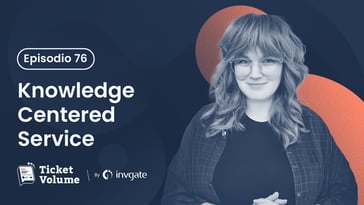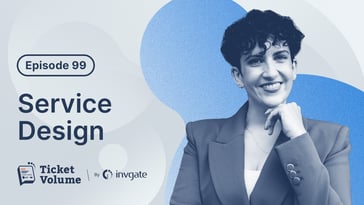IT Service Management (ITSM) establishes specific criteria to manage IT services and – as the name suggests – is oriented to the IT department. However, for quite some time, organizations have been attempting to expand ITSM beyond IT – with more or less success – by implementing shared services.
But though it might seem like just a change in the organization's methods, it also involves changing its mindset. To fully understand the scope of shared services – or as we know them now, Enterprise Service Management (ESM) – Matt Beran (InvGate Product Specialist and Ticket Volume host) chatted on the 31st episode of our IT podcast with Phyllis Drucker.
The author, keynote speaker, Service Management thought leader and Enterprise Service Management guru shared her thoughts on how to lay the groundwork to take ITSM beyond IT, how ESM should be approached, as well as the first steps to make it happen.
Keep reading for a quick written recap of the episode – and remember that you can register for our monthly live recordings and ask your questions live!

Understanding what shared services are all about
The first relevant thing to address is that the expansion of ITSM outside the IT department is not simply following new guidelines. It takes work to truly implement a shared service center, in the sense that it's not just the implementation of a new tool but the guarantee of a certain service quality offering.
So, the fact that other areas of the company adopt a ticketing system to channel inquiries is just part of what it takes to do it. Some requirements come along with that, and ultimately, a change in mindset.
|
|
Phyllis Drucker |
From Drucker's perspective, even though service portals now are broader to cover other company areas besides IT, they become enterprise service portals. Still, they're not equal to doing Enterprise Service Management.
How to implement shared services to achieve ESM
In her many years of experience, Drucker has seen it all. And one of the most common things she observed is that many organizations implement a shared self-service portal as the only measure to do ESM. However, we mentioned that expanding the use of a solution is not enough to actually do it.
|
|
"True Enterprise Service Management means that everybody offers the same experience. When you use that portal – regardless of whether it's HR, IT, Facilities, or a print room – you should get the same level of experience from all of them." Phyllis Drucker |
It's not just a matter of the tool you're using but the employee experience you provide across multiple departments and through that single platform. Of course, it's the first step, but you also need to ensure some other things, such as a common language and a consistent customer experience.
These are the three aspects to take into account when implementing shared services.
1. Evaluating the company departments and adding them to the portal
The first aspect to consider is which departments expand the ITSM framework. In order to evaluate their addition to the help desk, organizations need to acknowledge and understand the needs, processes, and best practices inherent to each area.
According to the author and speaker, ITSM cannot be approached in the same way for every department. In this sense, it's crucial to involve people from different departments in Service Management delivery to ensure the success of the shared service implementation.
Once you decide which areas to expand ITSM to (if you need some extra help with this, check out Darren Rose's episode!), you have to add them to the portal. The most popular one is Human Resources. In fact, Drucker explained that "HR is now in a spot where they are realizing they can't keep expanding the way they have been, and that's driving change towards ESM."
But that's not the end of it. The guest listed other areas susceptible to being added, like Facilities, printing services, parking lot services, or leased car services.
2. Providing a consistent customer experience
Now that you added multiple services to your portal, it's time to work on unifying the interactions to create a consistent customer experience.
|
|
Phyllis Drucker |
Ultimately, the goal is to provide a single portal for all services to make things easier for the whole company – workers, managers, new hires, etc. And that's something with which the Service Management Office (SMO) can help!
SMOs provide guidance for Service Management adoption programs, govern how tools are changed, and guide the user experience work that the organization is doing. So, if needed, they can also break down walls between IT and other departments by including people outside of IT in their meetings.
3. Having a common language
Drucker also mentioned that having a common language across departments is essential. The reason behind this is something we mentioned above: they all have different needs and processes, so IT vocabulary won't necessarily fit into HR or vice versa.
Hence, scaling and delivering services becomes difficult if all areas don't agree on common jargon and clarify concepts. For instance, Facilities Management may label issues as incidents or requests differently than IT or HR or have different turnaround times. To solve this complexity, you might classify something as an incident or a request based on its value and urgency.
The bottom line
This is just a short recap of the 31st episode of Ticket Volume with Phyllis Drucker, but there's so much more to go through! So, catch up on the full chat with InvGate Product Specialist Matt Beran to learn more about how to implement shared services in your organization and expand ITSM beyond IT!
You can find the full episode on Apple Podcasts, Spotify, YouTube, or your favorite podcast platform. And remember to subscribe if you want to be a part of the monthly live recordings!















